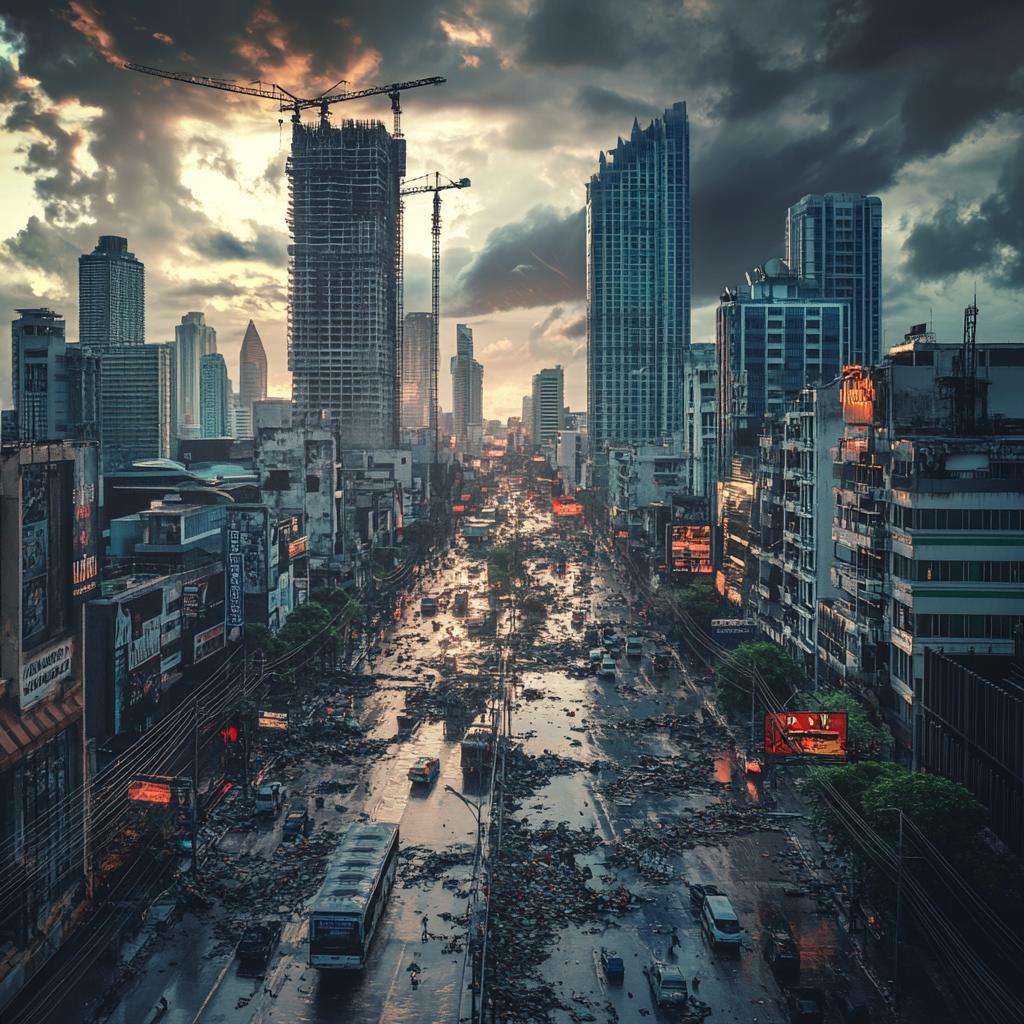In the heart of Southeast Asia, a dramatic sequence of events unfolded on Friday as a powerful earthquake rocked central Myanmar. Measuring a formidable 7.7 in magnitude and originating 10 kilometers below the surface near Mandalay, its tremors reverberated across borders, reaching the bustling streets of Bangkok and beyond. In mere moments, what was an ordinary afternoon morphed into a scene of chaos and uncertainty, as the earth’s volatile energy spilled into the lives of thousands.
Among the hardest hit by this seismic tempest were three construction sites in Bangkok, where a calamity unfolded with the collapse of a 30-storey government building. The devastation resulted tragically in 10 lives lost, 16 more injured, and an alarming 101 individuals unaccounted for, shaking the city to its core. “It was a scene of utter pandemonium,” recounted Bangkok’s Deputy Governor, Tavida Kamolvej, as the city’s spirit flickered amidst the tragedy.
The earthquake’s impact rippled far and wide, touching corners of Thailand, China, and Vietnam. Ten Thai provinces, including Samut Sakhon, Chiang Mai, and Chiang Rai, bore witness to the geological upheaval, as reported by Pasakorn Boonyalak, the vigilant director-general of the Department of Disaster Prevention and Mitigation.
Unrest lingered into the night, as the tremors remained unyielding in Mae Hong Son’s northern expanse. The Meteorological Department recorded an additional tectonic crescendo with a 4.1 magnitude quake at a depth of five kilometers, shaking Pai district at 11:21pm. As the shadows lengthened, a gentler, yet unmistakable 2.0 magnitude tremor followed past midnight, 3:24am, leaving its slight but unmistakable mark on the tranquility of the night.
Seismic aftershocks, a ghostly reminder of the earth’s earlier outburst, are expected to dance across Thailand’s terrain for the next one to two weeks, warned seismologist and structural engineering luminary, Prof. Dr. Pennung Warnitchai. “While the tremors may lack the ferocity of the initial quake, vigilance should remain the order of the day,” advised the AIT expert and director of Thailand’s National Earthquake Research Centre. His call was clear: the steel and concrete giants of the skyline must be scrutinized to ensure their endurance and safety, lest more lives find themselves precariously poised atop uncertain ground.
The mighty quake drew its strength from the Sagaing Fault in Myanmar, where the titanic Indian and Sunda plates engage in their ancient, tectonic dance. While the quake conformed to contemporary structural safety benchmarks for skyscrapers, Dr. Pennung’s insights illuminated the path forward, underscoring the gradual ebbing of aftershocks with time’s passage.
Now, as the dust settles and the human spirit begins to mend, thoughts turn to the lessons of resilience and response. The trembling earth may be a stark reminder of our planet’s restless lithosphere, but it also underscores the indomitable human resolve to rebuild, reassess, and rise once more from the rubble of disarray.


















This is a tragedy of monumental proportions. Why are we still not prepared for these disasters?
It’s hard to prepare for something so unpredictable. We need better early warning systems!
Agreed, but also stricter building codes could save lives next time.
The Indian and Sunda plates have been engaged in this ‘dance’ for millennia. We need to respect the power of nature!
It’s a stark reminder of how small we are in the grand scheme of things.
Absolutely. It’s moments like these that make you realize the planet’s true might.
With today’s technology, there’s no excuse for not having automatic building shut-off mechanisms to prevent damage.
That’s a good point. Imagine if the buildings could react autonomously to protect occupants.
There are systems like that in Japan; we should adopt them more widely.
Honestly, I don’t trust the figures they release. Sounds like they’re downplaying the severity.
Conspiracy theories don’t help anyone. Let’s stick to facts.
Sure, but who verifies those ‘facts’ anyway?
This should be a wake-up call for the region to improve infrastructure resilience.
I worry about the economic impact, though. Can these countries afford such upgrades?
True, but the cost of inaction could be much higher in lives and future damages.
Mother Nature is just fighting back, isn’t she?
That’s one way to see it, but we shouldn’t lose focus on scientific causes.
True, but it’s all interconnected. Our actions do affect the planet.
Terrifying to imagine the chaos in Bangkok during the collapse.
I can’t stop thinking about the families affected. It’s heartbreaking.
Me too, it’s an unimaginable tragedy for those involved.
Isn’t it normal for such earthquakes in this region? Seems like we should knew better.
Normal or not, we clearly need better systems in place to handle them.
What about the local wildlife? I bet they’ve been affected too.
Good point. Animals are often the forgotten victims in natural disasters.
Do you think this will spur governmental policy change, or is this just another unfortunate headline?
These disasters seem to be happening more frequently. Climate change is real, folks.
Not every natural disaster is linked to climate change. Let’s not jump to conclusions.
My heart goes out to all those affected. Such a massive tragedy.
We need more research funding in earthquake-prone areas to prevent future disasters.
This really shows the importance of early warning systems. Other regions should take note!
Agreed! Nations should collaborate to improve technology globally.